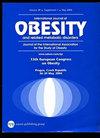哪种肥胖标志物与全因死亡率和特定原因死亡率最密切相关?一项对158699名墨西哥成年人的前瞻性研究。
IF 3.8
2区 医学
Q1 ENDOCRINOLOGY & METABOLISM
引用次数: 0
摘要
背景:各种方法被用来评估肥胖及其与发病率和死亡率的关系。在这项研究中,我们的目的是研究四种肥胖标志物与全因和病因特异性死亡率的关系,同时评估反向因果偏倚的潜在影响。方法:这项前瞻性队列研究包括来自墨西哥城前瞻性研究的158,699名参与者。采用Cox回归模型估计体重指数、腰围、腰高比和腰臀比与死亡风险的关系。为了尽量减少反向因果关系的影响,我们在基线时排除了患有流行疾病的参与者,并进行了额外的分析,排除了在前2年、5年和10年随访期间发生的死亡。结果:在15.5年的中位数中,记录了28,296例死亡。在排除了最初的2年、5年和10年随访后,腰围值高于被认为是高的推荐临界值与较高的全因死亡率相关(HR: 1.83;95% ci: 1.26-2.55, hr: 1.83;95% CI: 1.23-2.62, HR: 1.85;95% CI分别为1.14-2.70)。在相同的排除期,腰臀比升高与全因死亡率增加相关(HR: 1.71;95% ci: 1.07-2.30, hr: 1.70;95% CI: 1.05-2.49, HR: 1.71;95% ci: 1.01-2.52)。在排除前2年、5年和10年后,高腰围与CVD死亡率密切相关(HR: 4.76;95% ci: 1.70-11.82, hr: 4.75;95% CI: 1.56 ~ 11.88, HR: 4.73;95% CI分别为1.42-12.90)。腰臀比升高同样与心血管疾病死亡率相关(HR: 2.69;95% ci: 1.10-5.60, hr: 2.66;95% CI: 1.12-5.75, HR: 2.64;95% ci: 1.03-7.32)。身体质量指数、腰围、腰高比和腰臀比与呼吸系统和癌症死亡率无关。结论:腰围是与全因死亡率和心血管疾病死亡率最密切相关的肥胖标志,即使排除了前10年的随访。本文章由计算机程序翻译,如有差异,请以英文原文为准。
Which adiposity marker is most strongly associated with all‑cause and cause‑specific mortality? a prospective study of 158,699 Mexican adults
Various methods have been used to assess adiposity and its associations with morbidity and mortality. In this study, we aimed to examine the association of four adiposity markers with all‑cause and cause‑specific mortality, while evaluating the potential influence of reverse causation bias. This prospective cohort study included 158,699 participants from the Mexico City Prospective Study. Cox regression models were performed to estimate the associations of body mass index, waist circumference, waist-to-height ratio, and waist-to-hip ratio with mortality risk. To minimize the influence of reverse causation, we excluded participants with prevalent diseases at baseline and conducted additional analyses excluding deaths occurring within the first 2, 5, and 10 years of follow-up. Over a median of 15.5 years, 28,296 death were recorded. Waist circumference values above the recommended cutoff considered high were associated with higher all-cause mortality after the exclusion of the first 2, 5, and 10 years of follow-up (HR: 1.83; 95% CI: 1.26–2.55, HR: 1.83; 95% CI: 1.23–2.62, and HR: 1.85; 95% CI: 1.14–2.70, respectively). Elevated waist-to-hip ratio was associated with increased all-cause mortality across the same exclusion periods (HR: 1.71; 95% CI: 1.07–2.30, HR: 1.70; 95% CI: 1.05–2.49, and HR: 1.71; 95% CI: 1.01-2.52). High waist circumference was strongly associated with CVD mortality after exclusion of the first 2, 5, and 10 years (HR: 4.76; 95% CI: 1.70–11.82, HR: 4.75; 95% CI: 1.56–11.88, and HR: 4.73; 95% CI: 1.42–12.90, respectively). Elevated waist-to-hip ratio similarly showed associations with CVD mortality (HR: 2.69; 95% CI: 1.10–5.60, HR: 2.66; 95% CI: 1.12–5.75, and HR: 2.64; 95% CI: 1.03–7.32). Body mass index, waist circumference, waist-to-height ratio, and waist-hip ratio were not associated with respiratory and cancer mortality. Waist circumference was the adiposity marker most strongly associated with all-cause and CVD mortality, even after excluding the first 10 years of follow-up.
求助全文
通过发布文献求助,成功后即可免费获取论文全文。
去求助
来源期刊

International Journal of Obesity
医学-内分泌学与代谢
CiteScore
10.00
自引率
2.00%
发文量
221
审稿时长
3 months
期刊介绍:
The International Journal of Obesity is a multi-disciplinary forum for research describing basic, clinical and applied studies in biochemistry, physiology, genetics and nutrition, molecular, metabolic, psychological and epidemiological aspects of obesity and related disorders.
We publish a range of content types including original research articles, technical reports, reviews, correspondence and brief communications that elaborate on significant advances in the field and cover topical issues.
 求助内容:
求助内容: 应助结果提醒方式:
应助结果提醒方式:


